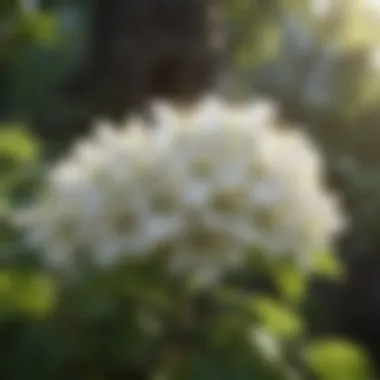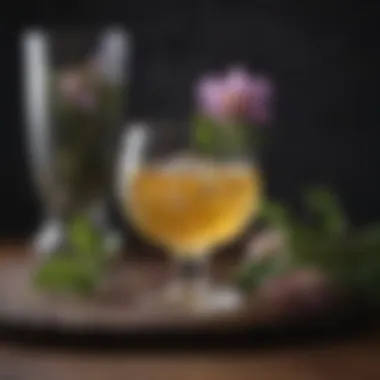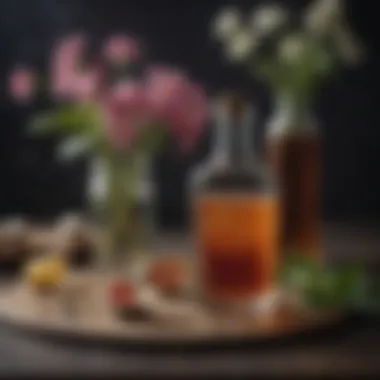Exploring the Flavor and Benefits of Elder Flower Cordial


Intro
Elder flower cordial has resurfaced in modern culinary circles, drawing attention from both enthusiasts and health-conscious individuals alike. Its unique flavor profile, combined with potential health benefits, has inspired many to explore its intricate aspects. This article will delve into the rich history of elder flower cordial, shedding light on its botanical details, production methods, culinary applications, and health advantages. Moreover, it will address safety considerations and the evolution of traditional recipes into contemporary forms.
In providing a thorough examination, we aim to equip readers with not only the knowledge needed to create this cordial at home but also an understanding of its place within the broader context of natural remedies and beverages.
Key Insights and Trends
Historical Significance
The elderflower, a product of the Sambucus tree, has been utilized for centuries. Ancient civilizations recognized its qualities, often using it for medicinal purposes. The practice has been passed down, evolving into today’s delicious elder flower cordial that we enjoy.
Modern Popularity
Currently, elder flower cordial is trending in gourmet recipes. Home cooks are drawn to its versatility, using it in beverages, desserts, and marinades. With the rise of natural ingredients in food and drink, elder flowers find their way into modern kitchens more than ever.
Elder flower cordial represents a balance between tradition and modernity, appealing to both nostalgic flavors and contemporary tastes.
Practical Tips and How-To Guides
Making Elder Flower Cordial at Home
To create a delectable elder flower cordial, follow these steps:
- Ingredients Needed:
- Preparation:
- Mixing:
- Infusion:
- Straining:
- Storage:
- Fresh elder flowers (about 20-30 heads)
- 1 liter of water
- 1 kg of granulated sugar
- 2 lemons (zested and juiced)
- 1 tablespoon of citric acid
- Pluck the elder flowers, ensuring no green stems are included to avoid bitterness.
- In a pot, bring water to a boil and dissolve the sugar.
- Add the elder flowers, lemon juice, lemon zest, and citric acid to the pot.
- Stir the mixture gently, then remove from heat.
- Allow the cordial to infuse for 24 hours, covered at room temperature.
- Strain the mixture through a fine sieve or cheesecloth into a sterilized bottle.
- The cordial can be stored in the refrigerator for several weeks. For longer preservation, consider freezing or bottling it.
Culinary Uses of Elder Flower Cordial
Elder flower cordial is widely appreciated for its adaptability in various recipes:
- Drinks: Mix with sparkling water for a refreshing beverage.
- Desserts: Drizzle over fruit or use in ice creams.
- Savory Dishes: Incorporate into dressings or marinades.
Prelude to Elder Flower Cordial
Elder flower cordial has become a notable beverage for home enthusiasts in recent years. Understanding this drink requires a look at its various aspects, including its definition, history, and uses. Elder flower cordial deserves attention for its unique taste that connects to cultural traditions, as well as its potential health benefits. It has emerged as not just a flavorful addition to drinks but also as a key element in natural remedy discussions. This section aims to introduce the significance of elder flower cordial, highlighting its importance as we unfold the topic in greater detail.
Defining Elder Flower Cordial
Elder flower cordial is a sweetened beverage made from the flowers of the elder tree, known scientifically as Sambucus nigra. This cordial offers distinct floral notes and a refreshing taste, often described as light and aromatic. It can be used in a variety of drinks, both alcoholic and non-alcoholic, or enjoyed neat. The process of making elder flower cordial involves infusing the flowers in water and sugar, creating a syrup that captures the essence of the blooms.
Historical Context
Traditional Uses
Elder flower cordial has deep roots in various cultures. Traditionally, it was utilized for its flavor and also valued in folk medicine. In many European countries, elder flowers were believed to have healing properties, making them a popular choice for various ailments. This historical relevance enhances the drink's appeal, showcasing how elder flower cordial lies at the intersection of culinary art and natural healing. Its widespread usage in seasonal festivities and family gatherings adds a layer of cultural significance, making it both a nostalgic beverage and a unique signature drink. Its sweet taste and versatility contribute to its enduring presence in home preparations, making it a popular choice for those looking to engage in DIY beverage crafting.
Regional Variations
The production and consumption of elder flower cordial can differ widely based on regional practices and ingredients. For instance, in the UK, the cordial is often enjoyed during spring and summer, celebrated for its lightness in warm climates. Conversely, in Scandinavian countries, elder flower flavors can accompany more robust drinks or be combined with other local ingredients.
These regional variations showcase the adaptability of elder flowers, allowing it to resonate with diverse palates while retaining its core attributes. Each regional approach presents unique methods and flavor enhancements, enriching the overall culinary tradition. Understanding these differences is crucial for appreciating elder flower cordial's widespread appeal, especially among those interested in home beverage preparation.


The Elder Flower: A Botanical Overview
The elder flower, known scientifically as Sambucus nigra, is not just a beautiful blossom; it plays a vital role in the production of elder flower cordial. This section provides a detailed exploration of the elder flower's classification, characteristics, growing conditions, and its significance in crafting this popular beverage. Understanding these botanical elements enhances our appreciation of elder flower cordial, connecting its delightful flavor to its natural origins. By examining the elder flower closely, we can appreciate how its properties contribute to both taste and potential health benefits.
Botanical Classification and Characteristics
The elder flower belongs to the Adoxaceae family. It is a deciduous shrub or small tree that can reach heights of 10-15 feet. The flowers are small, creamy white with a sweet scent, and appear in large, flat clusters during late spring. These blossoms are the focus for many gardeners and herbalists due to their fragrant aroma and culinary applications.
The elder tree has a distinctive bark that is light brown and pitted. The leaves are opposite and compound, giving the tree a lush appearance throughout the season. The flowers are often confused with other blooms, but their unique cluster formation can help identify them. The elder flower is not only aesthetically pleasing but also serves as a source of nectar for pollinators, thus playing a significant role in local ecosystems.
Growing Conditions and Cultivation
Growing elder flowers can be quite rewarding, provided the right conditions are met. Elder flowers thrive in many environments, but certain factors greatly influence their health and yield.
Preferred Climate
Elder flowers prefer a temperate climate, which supports their growth and flowering cycle. They flourish in areas with a clear distinction between warm and cold seasons. This climate ensures that the flowers bloom during spring when pollinators are active. An important characteristic of this climate is its ability to provide full sunlight during the flowering period. This increases nectar production, enhancing the flowers' appeal both to humans and to insects.
However, elder flowers can tolerate partial shade, making them versatile for different garden settings. Care must be taken in extremely hot or dry locales, as elder flowers require consistent moisture to produce quality blooms.
Soil Requirements
The soil requirements for elder flower cultivation are noteworthy. They prefer well-drained, fertile soils that are rich in organic matter. A slightly acidic to neutral pH level is ideal—between 6.0 to 7.5. This preference supports healthy root development, which is crucial for sustaining the shrub's growth.
One unique feature of the soil requirement is its adaptability; elder flowers can grow in poorer soils but will generally yield fewer blooms. This adaptation allows for growing elder flowers in various gardens, though the quality of the cordial may vary. Maintaining healthy soil through regular composting and mulching can greatly enhance the flowers' growth prospects.
Crafting Elder Flower Cordial
Crafting elder flower cordial represents a fundamental aspect of this article, illustrating the process that transforms simple ingredients into a sophisticated beverage. The process itself is both an art and a science, where the delicate flavors of elder flowers meld harmoniously with sugar and acidity. Understanding the crafting of elder flower cordial not only enhances appreciation for this traditional drink but also empowers enthusiasts to create their own. The benefits of homemade cordial include tailored flavor profiles and the joy of crafting something from natural ingredients. Furthermore, engaging in this process promotes connection with seasonal ingredients and local resources.
Ingredients and Equipment
To start crafting elder flower cordial, one must gather specific ingredients and equipment. The primary ingredient is, of course, the elder flowers, known for their unique floral aroma and light sweetness. Fresh elder flowers should be picked with care, ideally on a dry day, ensuring that they retain their flavor and fragrance.
Other ingredients include:
- Granulated sugar
- Water
- Citric acid or lemon juice (for acidity)
- Optional flavorings, such as spices or herbs.
Equipment needed consists of:
- A large pot for boiling
- A fine mesh strainer or cheesecloth
- Bottles for storage
- A stirring utensil, preferably non-reactive like wood or silicone.
Step-by-Step Preparation Process
The preparation process for elder flower cordial can be quite simple, yet it requires attention to detail.
Harvesting Elder Flowers
Harvesting elder flowers is the first step in the process, critically influencing the quality of the final product. This is best undertaken in late spring or early summer when flowers are in full bloom. The key characteristic of harvesting elder flowers is timing; they should be picked in dry weather, preferably early in the morning, when the flowers are fully opened but have not yet begun to wilt.
The benefit of freshly harvested elder flowers is their complex and intense flavor profile, which enhances the overall quality of the cordial. This process allows for the engagement with nature, creating a connection to the source of the beverage. However, one must also be careful about pollution as elderflowers can absorb environmental contaminants.
Infusion Techniques
Infusion techniques play a vital role in extracting the flavor from the elder flowers. Once harvested, the flowers should be rinsed gently to remove any insects or dirt. The flowers are then combined with sugar and boiling water, creating a solution for the extraction process.
A popular infusion method is using a cold infusion, which involves steeping the elder flowers in cold or room-temperature water for an extended period. This technique helps to preserve the delicate aromas and flavors.
While infusion can enhance flavor, it is crucial to monitor the steeping time. Over-infusion may result in bitter notes, detracting from the intended taste of the cordial. Thus, adjusting time and temperature is essential to achieve a well-balanced flavor.
Straining and Bottling
Straining and bottling is the final step in the cordial-making process. Once infused, the mixture should be strained to remove the elder flowers and any additional solids. This task can be done using a fine mesh strainer or cheesecloth to ensure a clear liquid.


The key characteristic of this step is the clarity and purity of the liquid. A well-strained cordial looks inviting and is pleasing to pour. After straining, the cordial can be bottled and stored, with proper sterilization of the bottles being paramount for preserving freshness.
Once bottled, elder flower cordial can be enjoyed immediately or stored in a cool, dark place for future use. This step is crucial as it determines the shelf life and flavor retention of the cordial, allowing people to enjoy it for months to come.
Culinary Applications of Elder Flower Cordial
Elder flower cordial emerges as a versatile ingredient in culinary practices. Its unique floral notes provide a distinct flavor that can elevate both beverages and desserts. The exploration of elder flower in culinary applications showcases its various uses and benefits, allowing enthusiasts to experiment in their kitchens. As more people seek natural flavors and ingredients, elder flower cordial is becoming more prominent. It presents a way to incorporate seasonal, locally sourced ingredients into daily menus.
Beverage Pairings and Mixology
Classic Cocktails
Classic cocktails incorporating elder flower cordial are notable for their refreshing qualities. These drinks benefit from the added floral essence, which balances stronger spirits. Elder flower adds a touch of sweetness without unnecessary heaviness. This aspect makes classic cocktails enjoyable and not overly cloying.
The incorporation of elder flower in established recipes, like the gin and tonic or the spritz, showcases its adaptability. Ingredients blend seamlessly while producing a vibrant visual appeal. Classic cocktails featuring elder flower cordial are a popular choice for social gatherings and celebrations.
Non-Alcoholic Variations
Non-alcoholic variations of elder flower cordial offer similar experiences without spirits. These drinks utilize the floral flavor to create refreshing alternatives for all ages. They make an excellent choice for family gatherings or daytime events.
Using elder flower syrup in spritzers or lemonades serves to enhance the overall drink experience. The uniqueness of non-alcoholic drinks lies in their ability to cater to a wide audience while remaining sophisticated. This opens possibilities for creative mixing with various juices and sodas.
Desserts and Baking
Flavor Enhancements
Elder flower cordial can enhance flavors in desserts, providing a light floral note. Adding a splash of cordial to cakes, panna cotta, or sorbets creates an elegant profile, enriching the dish's overall taste. The lightness of elder flower complements fruit-based desserts, bringing out natural sweetness.
Utilizing elder flower in desserts offers a unique twist, appealing to those looking to explore different flavor profiles. The delicate flavor adds sophistication to simple recipes, making them feel more special.
Recipe Ideas
Incorporating elder flower cordial in recipes is easy and rewarding. Simple recipes like elder flower cupcakes or infused fruit salads leverage its flavor effectively. Each desert benefits from the unique sweetness of elder flower, which allows for innovative preparation.
Including elder flower in everyday baking keeps interest alive in seasoned cooks. The versatility of elder flower cordial provides numerous possibilities. Experimenting with variations ensures both professional and home cooks can discover new culinary delights while using seasonal and fresh ingredients.
"Elder flower cordial transforms ordinary recipes into something extraordinary, embracing the beauty of seasonal ingredients."
Elder flower cordial is continually gaining recognition in culinary arts. Its adaptability and rich flavor profile make it a preferred choice. From beverages to desserts, it offers numerous applications, making it an ingredient worth exploring for any culinary enthusiast.
Health Benefits and Nutritional Value
Understanding the health benefits and nutritional value of elder flower cordial is crucial for those interested in both culinary practices and natural remedies. This section aims to shed light on the specific advantages offered by elder flower, while highlighting its nutritional attributes. Awareness of these aspects can help promote elder flower cordial as a beneficial addition to one's diet.
Potential Health Advantages
Anti-inflammatory Properties
Anti-inflammatory properties of elder flowers are noteworthy. The compounds present in elder flowers, such as flavonoids, are known for their ability to reduce inflammation in the body. This characteristic makes elder flower cordial a popular choice among those seeking natural alternatives to address inflammation-related concerns. Furthermore, these properties can aid in reducing symptoms of common ailments, such as arthritis or respiratory issues. The unique feature of elder flower's anti-inflammatory capacity contributes significantly to the overall health benefits linked to this cordial, making it a staple for health-conscious consumers.
Support for Respiratory Health
Elder flower has been traditionally used to support respiratory health. The cordial is thought to help alleviate symptoms associated with colds and flu, such as nasal congestion and coughs. Its natural constituents may work to soothe irritation in the respiratory tract, offering comfort during seasonal illnesses. The appeal of elder flower cordial as a remedy for respiratory issues enhances its value for individuals who often experience such conditions. Thus, leveraging this unique feature can provide an advantage in promoting better respiratory wellbeing among users.
Nutritional Composition
The nutritional composition of elder flower cordial adds another layer of interest. This cordial typically contains essential vitamins and minerals such as vitamin C, which plays an essential role in immune support. Moreover, elder flowers possess antioxidants that help neutralize harmful free radicals in the body. On the whole, the combination of these nutritional elements makes elder flower cordial not merely a flavorful beverage but also a substantial contributor to an enriched diet.
The potential health benefits coupled with its nutritional properties render elder flower cordial a remarkable inclusion for those striving for healthier lifestyle choices.
Safety and Contraindications
Understanding safety and contraindications is crucial when it comes to elder flower cordial. While it is generally considered safe for most people, there are instances where caution is necessary. Knowing about possible allergens and interactions with medications can help ensure a positive experience when consuming this product.


Possible Allergens
Elder flowers may trigger allergic reactions in some individuals. People who are sensitive to plants in the Adoxaceae family might be at risk. Symptoms can include skin rashes, respiratory issues, or gastrointestinal discomfort. It is vital to monitor any adverse effects after trying elder flower cordial for the first time.
- Common Signs of Allergic Reaction:
- Skin rash or hives
- Itching
- Swelling of the face, lips, or tongue
- Difficulty breathing
A gradual introduction, starting with a small amount, can help gauge one's tolerance. If allergic symptoms appear, discontinue use and seek medical attention if needed.
Interactions with Medications
Elder flower cordial may interact with certain medications, making it necessary for users to consult healthcare providers before consumption, especially those who are on medications with narrow therapeutic ranges. For example, elder flower can potentially enhance the effects of diuretics or blood thinners. This interaction could lead to increased risks of dehydration or bleeding.
- Medications that May Interact:
- Diuretics
- Anticoagulants
- Immunosuppressants
It is wise to be aware of any medication changes or new symptoms that arise when introducing elder flower cordial into one’s diet. Higher awareness can help mitigate risks and enhance safety.
"Consulting with a healthcare professional can prevent unforeseen complications when adding new herbal products to your regimen."
Being informed about these safety concerns allows for a more enjoyable and beneficial experience with elder flower cordial.
Modern Trends in Elder Flower Cordial Production
The production of elder flower cordial has seen a notable shift in recent years. As consumers become more health-conscious and environmentally aware, the demand for artisan and sustainably sourced products has increased. This trend is relevant not just culturally, but also economically as it invites both established brands and emerging producers into the market. Understanding the modern practices around elder flower cordial is essential for anyone wishing to appreciate its full potential.
Artisanal Approaches
Artisanal production methods have gained popularity among consumers looking for quality and authenticity. Many artisans focus on small-batch production using traditional recipes that emphasize the natural flavors of elder flowers. This approach allows producers to maintain control over their ingredients, often choosing organic elder flowers and minimizing preservatives. The result is a product that not only tastes better but also aligns with a growing desire for transparency in food sourcing.
Artisan brands often market their products based on their unique production processes and exclusive flavors. This contributes to a more personal consumer experience. People appreciate knowing where their food comes from and who made it.
Commercial Products and Market Trends
Commercial production of elder flower cordial is evolving. Large producers are recognizing the value in incorporating elder flower into their offerings. This shift represents a significant change in how consumers engage with this traditional beverage.
Emerging Brands
Emerging brands have entered the cordials market by crafting unique flavor combinations and focusing on premium ingredients. For example, companies like Belvoir Farm and Elderflower Pressé are notable for their dedicated sourcing of high-quality elder flowers. This characteristic differentiates them in a crowded market. Overall, emerging brands are popular among ecologically minded consumers looking for authenticity and quality in their beverages.
These brands often leverage social media to create buzz around their products. They promote their artisanal methods as well as the health benefits associated with elder flowers. While new brands face challenges in distribution and competition from established names, their focus on unique flavors often resonates well with customers.
Sustainability Practices
Sustainability practices in the production of elder flower cordial have attracted attention. Brands are increasingly aware of their impact on both the environment and local communities. Many producers use eco-friendly packaging and source foraging local elder flowers whenever possible.
This commitment to sustainability is beneficial not just for the companies but also for the consumers who are more environmentally conscious. By choosing products that prioritize sustainable practices, consumers support a market that values ecological health. This can create a positive feedback loop, encouraging more brands to adopt similar practices.
In summary, the modern trends in elder flower cordial production reflect a shift towards artisanal quality, sustainability, and innovative flavors. Both existing and emerging brands are adapting to meet consumer demand while ensuring the continued appreciation and relevance of elder flower cordial in contemporary culinary contexts.
Culmination
The conclusion of this article is essential as it encapsulates the significant aspects of elder flower cordial covered in previous sections. It serves as a recap and an invitation for further exploration of its rich history, recipe variations, and potential health benefits. Understanding elder flower cordial not only helps in appreciating its unique flavors but also encourages experimentation in home beverage preparation.
Recap of Key Points
Elder flower cordial stands out for several reasons:
- Historical Significance: Elder flowers have been used for centuries in various cultures, appreciated for their flavor and medicinal properties. This aspect provides a backdrop to the modern revival of the beverage.
- Crafting Process: The meticulous process of crafting elder flower cordial involves selecting the right flowers, understanding infusion techniques, and proper bottling methods. Each step plays a critical role in the final product's quality.
- Culinary Uses: The versatility of elder flower cordial in beverages and culinary applications makes it a valuable addition to both traditional and contemporary recipes.
- Health benefits: Potential health advantages, including anti-inflammatory and respiratory support properties, add another layer to its appeal.
- Safety Considerations: Being aware of possible allergens and medication interactions ensures safe consumption, enhancing the cordial's accessibility for more individuals.
Future of Elder Flower Cordial in Culinary Arts
The future of elder flower cordial appears promising in the culinary landscape. As more people lean toward natural ingredients and artisanal beverages, the demand for elder flower cordial is likely to increase. Here are several trends that may shape its future:
- Innovation in Recipes: Chefs and home cooks are likely to develop new recipes that integrate elder flower cordial in creative and unexpected ways, pushing the boundaries of traditional usage.
- Sustainable Practices: With rising environmental awareness, producers may focus more on sustainable cultivation and sourcing methods for elder flowers.
- Health-Conscious Beverages: As consumers become more health-conscious, beverages that offer both enjoyment and wellness benefits will gain traction.
- Cultural Exchange: The growing interest in global culinary traditions might lead to further exploration of elder flower cordial in diverse cuisines, reflecting its adaptability across cultures.
In summary, the exploration of elder flower cordial is both an appreciation for its past and a look at its potential in modern culinary practices. The promise it holds reflects a blend of tradition, health, and creativity, making it a subject worth delving into for those who aim to elevate their culinary creations.



